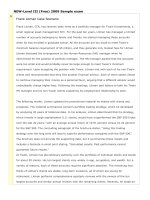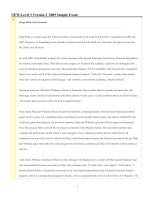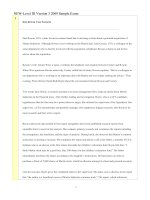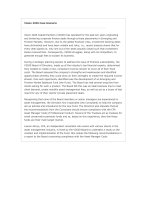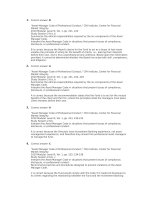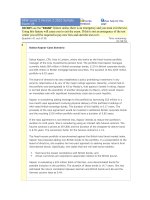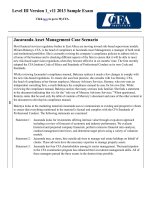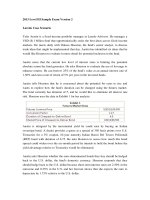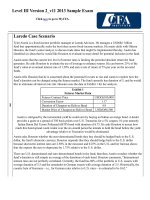2009 l3 sample exam v2 qa
Bạn đang xem bản rút gọn của tài liệu. Xem và tải ngay bản đầy đủ của tài liệu tại đây (183.01 KB, 23 trang )
NEW-Level 3 Version 2 2009 Sample Exam
1
Jorge Peña Case Scenario
Jorge Peña is a broker and CFA Institute member who passed Levels I and II of the CFA ® examination in 2006 and
2007. Because of a demanding work schedule, he did not enroll for the 2009 Level III exam. He hopes to enroll for the
2010 Level III exam.
In April 2009, Peña decides to apply for a broker position with regional brokerage firm Harvest Financial and updates
his résumé (curriculum vitae). Peña did not earn a degree, so he details his academic experience by stating the four
years he attended a prestigious university. He prominently displays “CFA® candidate” and states that he “completed
both Level I and Level II of the Chartered Financial Analyst Program.” Under the “Personal” section of his résumé,
Peña lists “referee for regional football league” and “member of investment committee, Mueller School.”
During an interview with Peter Williams of Harvest Financial, Peña explains that he currently has more than 100
brokerage clients. Based on relationships with those clients over the years, he feels confident that at least half of them
will transfer their accounts to Harvest if he is employed there.
Over lunch, Peña and Williams discuss his personal interests, including football. Peña has been refereeing football
games for five years. It is a significant time commitment, but he explains that he enjoys the activity and that the fees of
$50 per game more than pay for his travel expenses. Peña and Williams agree that $50 per game is not material. They
then discuss Peña’s role on the investment committee of the Mueller School. The committee monitors and evaluates the
performance of the school’s asset managers. It is a volunteer position, but the school allows all volunteers free use of the
school’s athletic facilities, which Peña enjoys because the facilities are state-of-the-art. Peña and Williams agree that
neither his refereeing nor his investment committee activities will interfere with his duties at Harvest.
After lunch, Williams introduces Peña to an old colleague who happens to be a client of Peña's current employer and
who also attended the same university as Peña. The colleague asks, “In what area is your degree?” Peña replies, “I
mostly studied finance. I found the coursework to be very helpful preparation for the Chartered Financial Analyst
program, which is a postgraduate program in finance. I have completed both Levels I and II of the CFA Program.” He
then adds, "You should leave your current broker. There are rumors they are in trouble; that's why I want to leave."
1
One month later, Peña accepts an offer of employment from Harvest Financial. On the first day in his new job, he hangs
a framed copy of the CFA Institute Code of Ethics on his wall and places a copy of the Standards of Practice Handbook
on his bookshelf for easy reference. When his supervisor mentions the Code hanging on the wall, Peña replies “I
conduct my business affairs so that I comply with both the Code and the Standards of Professional Conduct.” He does
not explain the Standards to his supervisor or mention the Handbook. Later that day, Peña uses public records to contact
his clients. He informs them of his new position and asks them to transfer their accounts to Harvest so that he can
continue acting as their broker. One month after starting his new job, only 25 of Peña’s clients have transferred their
accounts to Harvest.
At Harvest, Peña attends an educational seminar about a new tax-advantaged investment program available for clients
saving for college and university expenses. The program offers families the opportunity to obtain growth and
distribution of earnings that are free from federal taxes. More than 80 individual plans are available and more than onequarter provide additional local tax benefits. In the interest of time and for the sake of simplicity, the Harvest supervisor
provides information on only one plan, which offers only federal tax benefits.
During the seminar, the supervisor shows the federal tax savings available under the plan given a number of different
scenarios. He informs the brokers that the plan is subject to the same compliance and suitability requirements that apply
to the sale of non-tax-advantaged products. The supervisor then distributes the paperwork associated with the plan,
along with the firm’s compliance and suitability requirements.
At the end of the meeting, the supervisor states that he has already sold $400,000 worth of plans to his clients. He
encourages Peña and his colleagues to contact all their clients and share the information about the savings plans.
Question #1
When listing himself as a CFA® candidate on his résumé (curriculum vitae), did Peña violate any CFA Institute Standards of
Professional Conduct?
A. No.
2
B. Yes, because he may not refer to partial completion of the program.
C. Yes, because he must be enrolled to take the next scheduled exam to claim candidacy in the CFA ®
Program.
Correct Answer = C
"Guidance" for Standards I — VII, CFA Institute
2009 Modular Level III, Vol. 1, pp. 103-105
Ethics in Practice, Philip Lawton, CFA
2009 Modular Level III, Vol. 1, p. 162
Study Session 1-2-a, b
Demonstrate a thorough knowledge of the Code of Ethics and Standards of Professional Conduct by interpreting the Code
and Standards in various situations involving issues of professional integrity.
Distinguish between conduct that conforms to the Code and Standards and conduct that violates the Code and Standards.
Peña violated Standard VII (B), Responsibilities as a CFA Institute Member or CFA Candidate: References to CFA Institute,
the CFA Designation, and the CFA Program. Peña is not a candidate for the CFA charter because he is not enrolled to sit for a
specified examination.
2
With respect to the fees he receives as a football referee, has Peña violated any CFA Institute Standards?
A. No.
B. Yes, because he failed to receive written consent from his employer.
C. Yes, because he failed to receive written consent from all parties involved.
Correct Answer = A
"Guidance" for Standards I — VII, CFA Institute
2009 Modular Level III, Vol. 1, p. 75
Study Session 1-2-a, b
Demonstrate a thorough knowledge of the Code of Ethics and Standards of Professional Conduct by interpreting the Code and
Standards in various situations involving issues of professional integrity.
Distinguish between conduct that conforms to the Code and Standards and conduct that violates the Code and Standards.
Disclosure of additional compensation arrangements is required in situations where consideration might reasonably be
expected to create a conflict of interest with the employer's interest. The fees in question are small and unrelated to Peña's
professional activities. They create no conflict of interest with the employer.
3
According to CFA Institute Standards, after commencing employment with Harvest, is Peña required to make any additional
disclosures regarding his relationship with Mueller School?
A. No, because his supervisor agreed that his involvement will not interfere with his professional duties at
3
Harvest.
B. Yes, because he must disclose in writing to his immediate supervisor that he is a member of the school's
investment committee.
C. Yes, because he must not accept the use of the school's athletic facilities unless he obtains written consent
from both Harvest and Mueller School.
Correct Answer = C
"Guidance" for Standards I — VII, CFA Institute
2009 Modular Level III, Vol. 1, pp. 75-76
Study Session 1-2-a, b
Demonstrate a thorough knowledge of the Code of Ethics and Standards of Professional Conduct by interpreting the Code and
Standards in various situations involving issues of professional integrity.
Distinguish between conduct that conforms to the Code and Standards and conduct that violates the Code and Standards.
Peña must disclose benefits he receives in exchange for his services on the committee. According to Standard IV (B), Duties
to Employers: Additional Compensation Arrangements, members must not accept benefits or consideration that competes
with, or might reasonably be expected to create a conflict of interest with, their employer's interest unless they obtain written
consent from all parties involved.
4
During Peña's conversation with Williams' old colleague, which Standard below is least likely to have been violated?
A. Loyalty.
B. Misrepresentation.
C. Reference to the CFA Program.
Correct Answer = C
"Guidance" for Standards I — VII, CFA Institute
2009 Modular Level III, Vol. 1, pp. 29, 69, 103-107
Study Session 1-2-a, b
Demonstrate a thorough knowledge of the Code of Ethics and Standards of Professional Conduct by interpreting the Code and
Standards in various situations involving issues of professional integrity.
Distinguish between conduct that conforms to the Code and Standards and conduct that violates the Code and Standards.
In the conversation with Williams' old colleague, Peña did not violate Standard VII (B), Responsibilities as a CFA Institute
Member or CFA Candidate: Reference to CFA Institute, the CFA Designation, and the CFA Program, because he did not call
himself a candidate but explained his participation in the program and properly stated that he had passed Levels I and II of the
CFA Program.
5
Based only on the information describing his first month of employment at Harvest, did Peña violate any CFA Institute
4
Standards during that time?
A. No.
B. Yes, because he solicited clients from his previous employer.
C. Yes, because he failed to inform his supervisor in writing of his obligation to comply with the Code and
Standards.
Correct Answer = A
"Guidance" for Standards I — VII, CFA Institute
2009 Modular Level III, Vol. 1, pp. 15-17, 29-31, 69-71
Study Session 1-2-a, b
Demonstrate a thorough knowledge of the Code of Ethics and Standards of Professional Conduct by interpreting the Code and
Standards in various situations involving issues of professional integrity.
Distinguish between conduct that conforms to the Code and Standards and conduct that violates the Code and Standards.
No violation occurred. Peña is free to solicit clients using public information. Although Peña did not deliver as many clients
as he had hoped, he did not make any promises. Finally, while encouraged to do so, he is not obligated to inform his
supervisor in writing of his obligation to comply with the Code and Standards.
6
Based on the information provided regarding the tax-advantaged savings plan, the Harvest supervisor is least likely to have
violated the Standard:
A. relating to Suitability.
B. relating to Independence and Objectivity.
C. relating to Responsibilities of Supervisors.
Correct Answer = B
"Guidance" for Standards I — VII, CFA Institute
2009 Modular Level III, Vol. 1, pp. 21-23, 60-62, 76-78
Study Session 1-2-a, b
Demonstrate a thorough knowledge of the Code of Ethics and Standards of Professional Conduct by interpreting the Code and
Standards in various situations involving issues of professional integrity.
Distinguish between conduct that conforms to the Code and Standards and conduct that violates the Code and Standards.
The Standard regarding Independence and Objectivity requires members to use reasonable care to achieve independence and
objectivity. According to the Standard, members must not offer or accept any gifts or benefits that reasonably could be
expected to compromise their independence. Based on the information provided, the supervisor has not received any benefits
that would compromise his independence. Nevertheless, the supervisor failed to exercise thoroughness in analyzing the
various tax-advantaged plans and lacked a reasonable basis for suggesting one plan over the many others. As a supervisor, he
failed to establish adequate compliance procedures for determining the suitability of tax-advantaged programs, instead using
5
standard compliance procedures designed for non-tax-advantaged products. Finally, when selling the plan to his own clients,
he failed to consider the suitability of a plan offering only federal tax savings when other plans offered additional tax
advantages.
7
Yun Fan Case Scenario
Yun Fan manages a U.S.-based fixed income portfolio for JF Asset Management. The portfolio invests in Treasury
securities, non-callable investment grade corporate bonds, and mortgage-backed securities (MBS), all with durations of
about six years. Fan is meeting with a junior portfolio manager, Raj Mulloth, to discuss investment strategies for the
MBS portion of the portfolio.
Mulloth begins by stating that because Treasuries and mortgage securities in the portfolio have similar durations, they
both could be hedged against interest rate changes by using Treasury futures contracts. Fan comments that they both
must be hedged by selling Treasury futures, and that the dollar duration of the mortgage securities must equal the dollar
duration of the Treasury futures position.
The discussion then turns to the other sources of risk faced by investors in mortgage securities. Fan explains that in
addition to interest rate risk and prepayment risk, the other major sources of risk faced by mortgage securities include:
spread risk, yield curve risk, and volatility risk. Fan then makes the following statements:
Statement 1:
Spread risk should be hedged by selling Treasury futures contracts.
Statement 2:
Yield curve risk is the exposure to changes in the shape of the yield curve that impact our investments
in Treasury securities, non-callable corporates, and mortgage securities. Since the sum of all key rate
durations approximate the portfolio's duration, the portfolio's effective duration provides an effective
measure of our yield curve risk.
Statement 3:
Mortgage securities have significant exposure to volatility risk. Our expectation is that current implied
interest rate volatility will exceed future realized interest rate volatility.
Fan asks Mulloth to evaluate the sensitivity of a Ginnie Mae passthrough security in the portfolio to changes in the level
of interest rates and the shape of the yield curve. Mulloth asks if hedging mortgage securities using a duration-based
approach is equivalent to an interest rate sensitivity or two-bond hedge approach. Fan responds that these two
approaches both provide effective hedges. Mulloth then prepares a presentation for Fan with his findings. He first lists
the following assumptions he made in his analysis:
6
Assumption 1:
A typical steepening or flattening in the yield curve of 14 basis points, its historical average, in a given
month.
Assumption 2:
The average price change is an approximation of how the mortgage security price changes for a
significant change in interest rates.
Assumption 3:
Our proprietary prepayment model has proven to do a good job estimating how cash flows will change
when the yield curve changes.
Mulloth calculates the results of price changes using the two hedging
methodologies and the mortgage passthrough security and prepares the data
in Exhibit 1. Mulloth compares the annual spread to Treasuries of 168 basis
points earned for owning the Ginnie Mae to the hedging results in Exhibit 1.
Exhibit 1
Price Changes for Mortgage Security and Hedges
Increase in Yield
Decrease in Yield
Flattening
Steepening
Ginnie Mae 5.5%
(1.318)
1.189
(0.232)
0.233
Two-bond hedge
1.244
(1.263)
0.234
(0.232)
Duration hedge
1.338
(1.357)
-
-
Question 7
Assuming a decline in interest rates, is Mulloth correct with regard to using Treasury futures contracts to hedge the
interest rate risk of JF Asset Management's fixed income portfolio?
A. Yes.
B. No, the value of the prepayment option rises, causing mortgage security values to rise by less than
comparable Treasuries and rendering the hedge ineffective.
C. No, the value of the prepayment option declines, causing mortgage security values to rise by less than
comparable Treasuries and rendering the hedge ineffective.
Correct Answer = B
"Hedging Mortgage Securities to Capture Relative Value," Kenneth B. Dunn, Roberto M. Sella, and Frank J. Fabozzi
2009 Modular Level III, Vol. 4, pp. 146-148
Study Session 10-32-a
Demonstrate how a mortgage security's negative convexity will affect the performance of a hedge.
7
The value of mortgage security = value of a Treasury security — value of the prepayment option. If interest rates decline, the
value of the prepayment option rises and mortgage security values rise by less than comparable Treasury securities, thereby
rendering the hedge ineffective. The basic principle of hedging is that changes in the value of the security being hedged are
offset by changes in the value of the Treasury futures position.
8
Is Fan's comment to Mulloth regarding hedging mortgage securities by matching the dollar duration most likely correct?
A. Yes.
B. No, because if interest rates rise, duration for the positively convex Treasury increases more than for the
mortgage securities.
C. No, because if interest rates fall, the price of the mortgage securities will not rise as much as a comparable
Treasury security.
Correct Answer = C
"Hedging Mortgage Securities to Capture Relative Value," Kenneth B. Dunn, Roberto M. Sella, and Frank J. Fabozzi
2009 Modular Level III, Vol. 4, pp. 148-150
Study Session 10-32-a, b
Demonstrate how a mortgage security's negative convexity will affect the performance of a hedge.
Explain the risks associated with investing in mortgage securities and discuss whether these risks can be effectively hedged.
The appropriate action to hedge interest rate risk is to sell Treasury futures. However, matching the dollar duration of
mortgage securities and Treasury futures will not provide an appropriate hedge. This is because if interest rates fall, the
negative convexity of mortgage securities means the value of the mortgage security will not rise by as much as a comparable
Treasury security. The result is that changes in the value of the mortgage securities will not be correctly offset by changes in
the value of the Treasury futures position.
9
In Statement 1, is Fan most likely correct with regard to hedging spread risk?
A. Yes.
B. No, spread risk should be hedged only if spreads are expected to widen.
C. No, the spread is a risk premium for holding mortgage securities and should not be hedged.
Correct Answer = C
"Hedging Mortgage Securities to Capture Relative Value," Kenneth B. Dunn, Roberto M. Sella, and Frank J. Fabozzi
2009 Modular Level III, Vol. 4, pp. 150-151
Study Session 10-32-b
Explain the risks associated with investing in mortgage securities and discuss whether these risks can be effectively hedged.
8
Fan should not hedge against spread (OAS) widening. The spread is a risk premium for holding mortgage securities and
should not be hedged. By doing so, she will give up any benefit from spread narrowing. Instead Fan should invest in
mortgage securities when spreads offer attractive relative value to other fixed income securities.
10
In Statement 2, is Fan most likely correct with regard to the use of key rate durations?
A. Yes.
B. No, because yield curve risk for securities with bullet maturities cannot be properly measured by
effective duration.
C. No, because in a twist of the shape of the yield curve, callable bond prices will be more sensitive than
bullet bond prices.
Correct Answer = C
"Hedging Mortgage Securities to Capture Relative Value," Kenneth B. Dunn, Roberto M. Sella, and Frank J. Fabozzi
2009 Modular Level III, Vol. 4, pp. 151-153
Study Session 10-32-c
Contrast an individual mortgage security to a Treasury security with respect to the importance of yield curve risk.
Yield curve risk measures the exposure that a fixed income portfolio has to a non-parallel change in the shape of the yield
curve. The impact of a change in the shape of the yield curve can be quantified using key rate durations. However, individual
Treasury securities and non-callable corporate bonds have bullet maturities (the entire principal is due at maturity) and are
therefore sensitive to changes in the level of the yield curve, but not to changes in the shape of the yield curve. Mortgage
securities are amortizing securities and are sensitive to changes in the level of interest rates and to changes in the shape of the
yield curve. This is because the pattern of cash flows of mortgage securities can be impacted by changes in the shape of the
yield curve.
11
Which of Fan's assumptions is least likely to be accurate?
A. Assumption 1.
B. Assumption 2.
C. Assumption 3.
Correct Answer = B
"Hedging Mortgage Securities to Capture Relative Value," Kenneth B. Dunn, Roberto M. Sella, and Frank J. Fabozzi
2009 Modular Level III, Vol. 4, pp. 166-163
Study Session 10-32-d, e
Compare and contrast duration-based approaches versus interest rate sensitivity approaches to hedging mortgage securities.
9
Contrast a two-bond hedge that takes account of yield curve level and twist changes with a duration hedge.
The average price change is an approximation for a small, not a significant, change in interest rates.
12
Based on the results in Exhibit 1, does Mulloth's analysis show that he is most likely receiving sufficient spread on the
Ginnie Mae 5.5 percent mortgage after hedging costs?
A. No, because the cost for the duration hedge is not offset by the additional spread.
B. Yes, because the maximum loss under either the two-bond or duration hedge is lower than the
additional spread.
C. Yes, because hedging costs for the two-bond hedge is covered by the additional spread.
Correct Answer = C
"Hedging Mortgage Securities to Capture Relative Value," Kenneth B. Dunn, Roberto M. Sella, and Frank J. Fabozzi
2009 Modular Level III, Vol. 4, pp. 161-164
Study Session 10-32-e
Contrast a two-bond hedge that takes account of yield curve level and twist changes with a duration hedge.
The right hedging strategy to use for mortgage securities for both changes in the level and shape of the yield curve is the
two-bond hedge. The hedging cost is calculated by subtracting the changes in the Ginnie Mae with the two-bond hedge.
Ginnie Mae 5.5%
(1.318)
1.189
(0.232)
0.233
Two-bond hedge
1.244
(1.263)
0.234
(0.232)
Error
-0.074
-0.074
0.0002
0.001
The cost under the scenarios presented is —0.074 basis points. The 168 basis spread offers a monthly carry advantage of 14
basis points (168 / 12), which more than offsets the hedging cost.
13
Giles Morgan Case Scenario
Giles Morgan, a portfolio manager at Severn Capital, a British institutional asset manager, is meeting the investment
committee for Cotswold Industries' pension plan. Cotswold, based in the United Kingdom and a client of Severn, has
traditionally been conservative, and the pension plan's portfolio is diversified among U.K. and non-U.K. developedcountry securities.
10
Morgan states: "There are several benefits from having international securities in a portfolio. These include:
improved covariance relations across the portfolio's exposures, resulting in greater diversification benefits;
a wider range of industry and company choices for portfolio construction purposes."
Jama Pillai, a committee member, states, "I think the best diversification vehicle is an asset with high volatility and
negative correlation with our current portfolio."
Pillai then asks Morgan, "I understand that emerging markets can provide
attractive investment returns, but what are the risks?" Morgan responds to
Pillai, "Yes, emerging markets can provide attractive returns and you should
consider allocating a part of the pension portfolio to emerging markets.
However, there are several significant sources of risk that must be considered:
Statement 1: The distribution of emerging market stock returns are not symmetrical and standard deviation is not a good
measure of risk.
Statement 2: During periods of international crises, correlations increase thereby negating some of the benefits of investing
in emerging markets.
To illustrate the impact of exchange rates, Morgan provides the data in Exhibit
1.
Exhibit 1
Mexican Equity Portfolio and Currency Data
Current Portfolio Value in Mexican Pesos (MXN)
20,000,000
Portfolio Value in Mexican Pesos (MXN) after one month
21,000,000
Current Exchange Rate (GBP/MXN)*
0.0494
Expected Exchange Rate (GBP/MXN) after one month*
0.0490
Standard Deviation of Mexican Equity Market Returns in Pesos
8.25%
Standard Deviation of Exchange Rate (GBP/MXN)
4.85%
Correlation between Mexican Equity Market Returns in Pesos and the Exchange Rate
(GBP/MXN)
* British Pound – Mexican Peso
11
0.15
To conclude his presentation, Morgan states, "Currency risk is not an issue over the short term; however, over longer
holding periods, currency risk is a significant concern."
Question 13
Morgan's statement on the benefits of having international securities in a portfolio most likely is:
A. correct.
B. incorrect, because covariance relations are not improved.
C. incorrect, because the range of industry and company choices for portfolio construction is not
widened.
Correct Answer = A
"The Case for International Diversification," Bruno Solnik and Dennis McLeavey
2009 Modular Level III, Vol. 3, pp. 352-353, 378-379
Study Session 8-28-a
Evaluate the implications of international diversification for domestic equity and fixed income portfolios, based on the
traditional assumptions of low correlations across international markets.
Morgan's statement is correct; all the points he makes are benefits of international diversification.
14 Is Pillai's statement most likely correct?
A. Yes.
B. No, high volatility and positive correlation are more desirable.
C. No, low volatility and negative correlation are more desirable.
Correct Answer = A
"The Case for International Diversification," Bruno Solnik and Dennis McLeavey
2009 Modular Level III, Vol. 3, pp. 352-353, 389, A20 (problem 4 and its solution)
Study Session 8-28-a
Evaluate the implications of international diversification for domestic equity and fixed income portfolios, based on the
traditional assumptions of low correlations across international markets.
The best diversification vehicle will have negative correlation with the existing portfolio, so it will move up when the
portfolio falls, and high volatility, so it will have large upswings when the portfolio falls.
12
15 Is Morgan most likely correct about the sources of risk in emerging markets?
A. Yes.
B. No, Statement 1 is incorrect.
C. No, Statement 2 is incorrect.
Correct Answer = A
"The Case for International Diversification," Bruno Solnik and Dennis McLeavey
2009 Modular Level III, Vol. 3, pp. 382-386
Study Session 8-28-j
Summarize the basic case for investing in emerging markets as well as the risks and restrictions often associated with such
investments.
All the points made by Morgan are risks associated with investing in emerging markets.
16 Based on the information in Exhibit 1, the one-month British Pound (GBP) return on the portfolio is closest to:
A. -3.98%.
B. 4.15%.
C. 5.00%.
Correct Answer = B
"The Case for International Diversification," Bruno Solnik and Dennis McLeavey
2009 Modular Level III, Vol. 3, p. 353
Study Session 8-28-b
Distinguish between the asset return and currency return for an international security.
The return in pounds is 4.15%.
The unhedged return is given by:
where R* is the return in pounds, Vt* and V0* are time t and initial portfolio values in pounds, Vt and V0 are values in pesos,
and St and S0 are time t and initial exchange rates, respectively. Then,
13
17 The contribution of currency risk is closest to:
A. 0.36 %.
B. 1.93%.
C. 4.85 %.
Correct Answer = B
"The Case for International Diversification," Bruno Solnik and Dennis McLeavey
2009 Modular Level III, Vol. 3, pp. 354-355
Study Session 8-28-c
Evaluate the contribution of currency risk to the volatility of an international security position.
The contribution to currency risk = σf — σ = 10.18% — 8.25% = 1.93%
The standard deviation of Mexican equity returns measure in pounds is =
σf = [σ2 + σ2 s + 2 × ρ × σ × σs]0.5 = [0.010359 + 0.002352 + 2 × 0.15 × 0.0825 × 0.0485]0.5 = 0.10178
σs = standard deviation of exchange rate = 0.0425
The standard deviation of Mexican equity market returns measured is pesos = σ = 8.25%.
18 Is Morgan's concluding statement on currency risk most likely correct?
A. Yes.
B. No, he is incorrect about currency risk in the short and long term.
C. No, he is correct about currency risk in the short term and incorrect about currency risk in the long term.
Correct Answer = B
"The Case for International Diversification," Bruno Solnik and Dennis McLeavey
2009 Modular Level III, Vol. 3, pp. 368-369
Study Session 8-28-f
Explain why currency risk should not be a significant barrier to international investment.
He is incorrect about currency risk in the short and long term. Contrary to what Morgan states, currency risk is less of an
issue over the long term. However, over short time horizons, currency risk can be a significant concern.
19
Triden Capital Case Scenario
14
Triden Capital, an investment management firm, invests high net worth clients’ capital in actively traded domestic
equity and fixed income securities. Senior management has recently adopted an Enterprise Risk Management (ERM)
governance structure to identify and measure both financial and non-financial risks to which Triden is exposed. It is
exploring the use of value at risk (VAR) to measure market risk.
Senior management meets with David Smith, an investment consultant, to discuss risk management practices. Smith
explains that the investment industry has developed a set of standardized methods for estimating VAR. To determine
the most appropriate method for Triden, management must determine an appropriate approach to model the loss
distribution. Management assumes that the firm’s portfolio returns are normally distributed.
Smith recommends that Triden adopt stress testing to enhance the understanding of risks faced by the firm.
Management asks Smith to justify his stress testing recommendation.
The firm’s equity portfolio is focused on large-cap companies with attractive valuations and has a market value of $500
million. The expected annual return of the equity portfolio is 10 percent with a standard deviation of 0.20. Using one of
the VAR methods, Smith determined that the daily VAR of the equity portfolio is approximately $10 million at a
probability of 5 percent.
The firm’s fixed income portfolio is focused on duration and credit and has a market value of $300 million. The
expected annual return of the fixed income portfolio is 6 percent with a standard deviation of 0.10. Portfolio managers
within the firm are able to use derivatives, including swaps and options, as yield enhancement vehicles.
An equity portfolio manager sold 3-month European calls on Versa Corporation last month. The current market value
of the calls is $394,000. Also one month ago, one of the firm’s fixed income portfolio managers entered into a 1-year,
plain vanilla interest rate swap with quarterly resets last month. The portfolio manager receives fixed rate payments and
pays floating rate payments. The current market value of the swap is $(468,000).
Another equity portfolio manager is interested in establishing a call-overwriting program. Senior management asks
15
Smith for his recommendation for evaluating the performance of such a portfolio on a risk-adjusted basis.
Question 19
Given senior management's assumption about return distributions, the most appropriate VAR method for Triden Capital to
use is the:
A. historical method.
B. Monte Carlo Simulation method.
C. analytical method.
Correct Answer = C
"Risk Management," Don M. Chance, Kenneth Grant, and John Marsland
2009 Modular Level III, Vol. 5, p. 213
Study Session 14-40-f
Compare and contrast the analytical (variance-covariance), historical, and Monte Carlo methods for estimating VAR and
discuss the advantages and disadvantages of each.
The analytical method is based on the assumption that portfolio returns are normally distributed.
20 If Smith's VAR calculation is accurate, which of these other VAR estimates could be accurate for the equity portfolio?
A. $5 million at a probability of 1% over 1 day.
B. $7.5 million at a probability of 5% over 1 month.
C. $60 million at a probability of 1% over 1 month.
Correct Answer = C
"Risk Management," Don M. Chance, Kenneth Grant, and John Marsland
2009 Modular Level III, Vol. 5, pp. 211-213
Study Session 14-40-e
Interpret and compute value at risk (VAR) and explain its role in measuring overall and individual position market risk.
Lowering the probability and increasing the time horizon will increase the VAR.
21 Smith's best response to justify stress testing is that it seeks to identify the:
A. risk variable that will produce the maximum loss.
B. unusual circumstances that could lead to excess losses.
16
C. portfolio performance under different states of the world.
Correct Answer = B
"Risk Management," Don M. Chance, Kenneth Grant, and John Marsland
2009 Modular Level III, Vol. 5, pp. 227-229
Study Session 14-40-g
Discuss the advantages and limitations of VAR and its extensions, including cash flow at risk, earnings at risk, and tail value
at risk.
Stress testing can provide additional information regarding unusual circumstances that could result in a loss greater than that
calculated with VAR, which looks at normal market conditions only.
22 Triden Capital is least likely to be exposed to:
A. credit risk.
B. settlement risk.
C. exchange rate risk.
Correct Answer = C
"Risk Management," Don M. Chance, Kenneth Grant, and John Marsland
2009 Modular Level III, Vol. 5, pp. 197-209
Study Session 14-40-b
Recommend and justify the risk exposures an analyst should report as part of an enterprise risk management system.
The firm invests in domestic securities and therefore has no exposure to foreign currency.
23 What is Triden Capital's current credit risk associated with the plain vanilla interest rate swap?
A. $ -468,000.
B. $0.
C. $468,000.
Correct Answer = B
"Risk Management," Don M. Chance, Kenneth Grant, and John Marsland
2009 Modular Level III, Vol. 5, pp. 233-236
Study Session 14-40-i
Evaluate the credit risk of an investment position, including forward contract, swap, and option positions.
Triden is 30 days into the life of a 1-year swap with quarterly payments. No payment is due for 60 days. The current credit
risk is $0 until a payment is due.
17
24 The most appropriate measure for evaluating the performance of the proposed call-overwriting program would be the:
A. Sharpe ratio.
B. Sortino ratio.
C. return over maximum drawdown.
Correct Answer = B
"Risk Management," Don M. Chance, Kenneth Grant, and John Marsland
2009 Modular Level III, Vol. 5, pp. 247-249
Study Session 14-40-l
Compare and contrast the Sharpe ratio, risk-adjusted return on capital, return over maximum drawdown, and the Sortino ratio
as measures of risk-adjusted performance.
The Sortino ratio considers optionality and does not penalize portfolio managers for volatility derived from outsized positive
performance.
25
Omega Analytics Case Scenario
Omega Analytics provides risk management consulting for institutional and individual clients. Rachel Osborne, CFA, is
an investment advisor for Omega who works with the firm's larger accounts. She is considering derivative strategies for
several clients.
HMM Foundation owns 30,000 shares of Nasdaq 100 Index Tracking Stock (Symbol: QQQQ),
which has a current price of $30 per share. Osborne believes that there is substantial risk of
downside price movement in the index over the next six months. She recommends that HMM
use a six-month collar for the entire position of 30,000 shares as protection against the QQQQ
price falling below $27. Exhibit 1 gives exercise prices and option premiums (per share) for
QQQQ puts and calls expiring in 6 months.
Exhibit 1
QQQQ Puts and Calls Expiring in Six Months
Option Type
Exercise Price ($)
Option Premium ($)
Call
35
0.80
Put
27
0.95
The QQQQ Index option contract is for 100 shares of the index tracking stock. HMM would hold the collar strategy
18
until expiration of the put and call options.
Bob Valentine believes that the prices of large capitalization stocks will rise slightly and he
wants to profit from this movement using a bull spread strategy. Osborne recommends that
Valentine use Dow Jones Industrial Average (DJX) options that expire in two months. The
current price of DJX is $91. Exhibit 2 gives exercise prices, call option premiums (per one
share), and deltas (calculated from the Black-Scholes-Merton option-pricing model) for two
DJX call options expiring in two months.
Exhibit 2
DJX Call Options Expiring in Two Months
Exercise Price ($)
Option Premium ($)
Delta
88
4.40
0.75
94
1.00
0.30
The total cost of one contract is the quoted premium times the contract multiplier, which is 100 shares per contract.
Valentine decides to use 100 contracts per position.
The Bedford Trust is focused on long-term growth and is invested only in equity. The trust has an equity portfolio
with a market value of $60 million, of which $20 million is allocated to WTO stock. Its trustees are considering a
temporary decrease in the allocation to WTO stock in order to diversify into small-capitalization U.S. stocks.
Osborne recommends the Russell 2000 Index as an appropriate small-capitalization index and notes that three swap
dealers have offered to swap the returns on WTO and the Russell 2000 at no spread.
Kung Chen expects the tracking stock on the Dow Jones Industrial Average (DIA) to trade
within a narrow range around its current price over the near term. Based on his expectation, he
believes a profitable trading opportunity is to initiate a butterfly spread strategy using call
options on DIA. Osborne suggests using three one-month call options on DIA. Each option
contract is for 100 shares. Exhibit 3 gives exercise prices and option premiums for three DIA call
options expiring in one month.
Exhibit 3
DIA Call Options Expiring in One Month
Exercise Price ($)
Option Premium ($)
88
4.20
92
2.00
96
0.50
19
Chen wants a butterfly spread using a total of 200 long contracts and 200 short contracts.
Question 25
If the HHM Foundation enters into the collar recommended by Osborne and the market value of QQQQ is $33 at the
expiration date of the options, the profit from the position would be closest to:
A. $85,500.
B. $90,000.
C. $94,500.
Correct Answer = A
"Risk Management Applications of Option Strategies," Don M. Chance
2009 Modular Level III, Vol. 5, pp. 389-393
Study Session 15-43-a
Determine and interpret the value at expiration, profit, maximum profit, maximum loss, breakeven underlying price at
expiration, and general shape of the graph for the major option strategies (bull spread, bear spread, butterfly spread, collar,
straddle, box spread).
The profit per collar = ST + max(0, X1 – ST) – max(0, ST – X2) – S0 – (p0 – c0), where:
S0, ST = price of underlying at time 0 and time T
X1 = exercise price of put
X2 = exercise price of call
Ρ0 = price of put at time 0
c0 = price of call at time 0
Profit = 33 + 0 – 0 – 30 – 0.15 = 2.85
Total profit = $2.85 × 30,000 = $85,500
26 If the HHM Foundation enters into the collar recommended by Osborne, the maximum potential profit from the position at
expiration of the options is closest to:
A. $145,500.
B. $150,000.
C. $154,500.
Correct Answer = A
20
"Risk Management Applications of Option Strategies," Don M. Chance
2009 Modular Level III, Vol. 5, pp. 389-393
Study Session 15-43-a
Determine and interpret the value at expiration, profit, maximum profit, maximum loss, breakeven underlying price at
expiration, and general shape of the graph for the major option strategies (bull spread, bear spread, butterfly spread, collar,
straddle, box spread).
The maximum profit on the collar occurs when the short call expires at the money, i.e., QQQQ = $35.
Max profit per collar = ST + max(0, X1 — ST) — max(0, ST — X2) — S0 — (p0 — c0).
Max profit per collar = 35 + 0 — 0 — 30 — 0.15 = $4.85
Total max profit = 4.85 × 30,000 = $145,500.
27 At expiration of the DJX call options, the maximum potential profit from bull spread strategy recommended for Valentine is
closest to:
A. $6,000.
B. $26,000.
C. $60,000.
Correct Answer = B
"Risk Management Applications of Option Strategies," Don M. Chance
2009 Modular Level III, Vol. 5, pp. 379-382
Study Session 15-43-a
Determine and interpret the value at expiration, profit, maximum profit, maximum loss, breakeven underlying price at
expiration, and general shape of the graph for the major option strategies (bull spread, bear spread, butterfly spread, collar,
straddle, box spread).
A bull spread combines a long call at a lower exercise price (X1 = 88) and a short call at a higher exercise price (X2 = 94).
The cost of X1 is c1 = —$4.40 and the cost of X2 is c2 = +$1.00.
The maximum profit per contract = (X2 – X1 – c1 + c2) × 100
= ($94 – $88 – $4.40 + $1.00) × 100
= 2.60 × 100 = $260
The maximum profit for 100 contracts is $260 × 100 = $26,000.
28 Omega Analytics provides risk management consulting for institutional and The delta of Valentine's bull spread just before
contract expiration, if the price of DJX is $93, will be in the range of:
A. 0.00 to 0.20.
B. 0.40 to 0.60.
21
C. 0.80 to 1.00.
Correct Answer = C
"Risk Management Applications of Option Strategies," Don M. Chance
2009 Modular Level III, Vol. 5, pp. 421-424
Study Session 15-43-d
Explain why and how a dealer delta hedges an option portfolio, why the portfolio delta changes, and how the dealer adjusts
the position to maintain the hedge.
If the price of DJX = $93, then the long call (exercise price = $88) will be in the money and its delta would be close to 1.0.
The short call (exercise price = $94) will be out of the money and (very close to expiration) its delta would be close to 0.0.
The overall delta is then very close to 1.0.
29 Bedford Trust reduces the WTO exposure through an equity swap on the Russell 2000 Index. The swap has quarterly
payments and the Trustees are concerned that it may create cash flow problems. What market scenario will most likely create
a cash flow problem for the trust during a quarter?
A. Russell 2000 return is negative and the WTO is positive.
B. Russell 2000 return is positive and the WTO return is zero.
C. The Russell 2000 and WTO return are both positive and the Russell 2000 return is larger.
Correct Answer = A
"Risk Management Applications of Swap Strategies," Don M. Chance
2009 Modular Level III, Vol. 5, pp. 464-466
Study Session 15-44-g
Explain how equity swaps can be used to diversify a concentrated equity portfolio, provide international diversification to a
domestic portfolio, and alter portfolio allocations to stocks and bonds.
The trust has entered into a swap in which it pays the difference between the WTO return and the Russell 2000 Index return.
In this case, the trust's position is clearly negative (because a positive minus a negative is always positive) and therefore the
trust will pay a cash outflow.
30 If Chen creates a butterfly spread using the three 1-month call options suggested by Osborne, the maximum potential loss at
expiration is closest to:
A. $3,000.
B. $7,000.
C. $27,000.
Correct Answer = B
22
"Risk Management Applications of Option Strategies," Don M. Chance
2009 Modular Level III, Vol. 5, pp. 385-389
Study Session 15-43-a
Determine and interpret the value at expiration, profit, maximum profit, maximum loss, breakeven underlying price at
expiration, and general shape of the graph for the major option strategies (bull spread, bear spread, butterfly spread, collar,
straddle, box spread).
A butterfly spread involves call options with three different exercise prices: the investor goes long one call each at the lowest
and highest exercise prices, and short two calls at the middle exercise price. In this case, Chen is long 100 calls at X 1 = 88 (c1
= 4.20), short 200 calls at X2 = 92 (c2 = 2.00), and long 100 calls at X3 = 96 (c3 = 0.50).
Maximum loss per contract = c1 – 2c2 + c3
= ($4.20 – (2 × $2.00) + $0.50) × 100
= $0.70 × 100 = $70
To find the maximum loss at expiration for Chen's spread strategy, multiply the per contract payoff by 100, or $70 × 100 =
$7,000.
23

